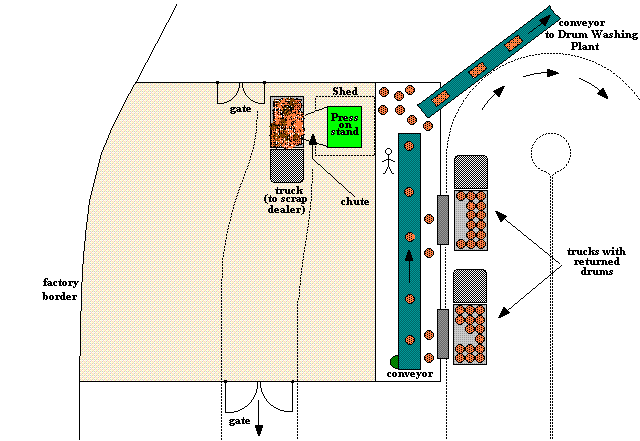|
Analysis
The lean approach always looks at things from a value-adding/non-value-adding angle of view.
In the present state, there are numerous non-value-adding (NVA) activities, some necessary some totally redundant:
-
Off-loading of returned drums - NVA, but necessary
-
Inspecting/checking returned drums for damages, etc. - NVA but necessary
-
Positioning unusable drums on concrete slab - NVA
-
Rolling drums down to yard - NVA
-
Stockpiling drums in the yard - NVA (and offensive from an house-keeping point of view)
-
Bringing drums from yard stockpile to press for flattening - NVA
-
Removing flattened drums from press and stockpiling same waiting to be loaded on truck - NVA
-
Loading truck with flattened drums for onward transportation to scrap metal dealer - NVA (arguable)
Therefore the bulk of the waste is in handling/double-handling.
[NB: other items of activities could be questioned, from the collection of drums at clients' premises to the actual selling of unusable drums as scrap. A solid brainstorming session would come up with very interesting and intriguing ideas (as it really happened in this case), but this falls out of the scope of this tutorial.]
Without going into futuristic and super-star-galactica technology solution & conclusionss (anyhow not acceptable under the constraints set by management), the lean solution & conclusions points at eliminating as much handling as possible.
Since there are 3 actors in this story (the drums inspector and the 2 flattening labourers), one initial thought focuses on the "who is really adding-value and really necessary in this scenario".
The answer is very simple: the only really necessary actor in this case is the inspector: necessary, because someone has to decide whether a drum can still be used and filled with product again, or should rather be scrapped. And the 2 labourers? The 2 labourers mostly reshuffle waste.
Brainstorming challenge (the famous Edward De Bono's Creative Challenge): can we conceive a system in which the drums inspector, alone, could run the entire show?
Remember! The inspector checks, inspects AND physically handles each and every returned drum: either to put it on the conveyor to Washing Plant (good drums), or to put it on the concrete slab (unusable drums).
How could he handle the entire process, in (almost) continuous flow mode?
Simple: by re-locating the press as close to him as possible!
Hence the lean solution & conclusions that was actually proposed as future state and then approved and immediately implemented. See the future state plan and side views here below:


The proposed future state is lean because:
-
The bulk of the waste (all handling, rolling, stacking, re-handling, piling and loading) has been removed: all is left is minimal handling (after each drum inspection) to position it either on the conveyor to Washing Plant (good drum) or directly onto the press (unusable drum)
-
The flow is practically continuous: the inspector activates the press - each flattened drum (very short flattening cycle-time) is then simply thrown out of the press onto a chute by the inspector (with a metal stick). The flattened drum falls straight onto the truck (or, even better: a trailer!!) that will go to the scrap metal dealer once full.
The proposed future state meets constraints and limitations because:
-
There is no longer any mess in the yard (it could now be used to plant trees and shrubs.... which actually was done)
-
There are no more injuries, due to the elimination of all handling, especially of flattened drums
-
It's economical: building another concrete slab - building a steel frame structure on top of it - re-positioning the press onto the frame structure - fabricating a sheetmetal chute - and doing some minor electrical wiring - costs much less than 2 years' salaries for the yard workers
-
It's rather fast to implement (in actual fact, it took about one month.....)
And the 2 yard workers?
They were redeployed elsewhere.
A final comment:
When I assign this case study as a team exercise during my courses and seminars, there is a strong and distinct tendency (+- 60%) to go for what I call "super-star-galactica" solution & conclusionss: all sorts of fully automated handling/flattening/loading lines (costing an arm and a leg) are "invented" in the half an hour I normally give to come up with a lean solution & conclusions.
Not so good!
Remember! In a lean environment:
- people first
- methods (lean) second
- technology third (only third)
And remember as well! Gravity (the force of gravity) is fantastic: it's everywhere, abundant, and free-of-charge!!!
Read the case again - click here
Would you like to comment on this tutorial?
Would you like to suggest another solution & conclusions for this case?
Your comments and feed-back are most welcome - please contact Carlo Scodanibbio.
|



